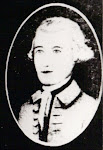Artificers and Laborers at Mount Tirzah in Caswell County, North Carolina, 1781-1782
by Terri Bradshaw O’Neill* - 2009©
Col. Stephen Moore moved his family from his native New York to North Carolina sometime between May of 1775 and September of 1776. (Family letters: Rebecca Moore to Stephen Moore at West Point, 10 May 1775; Stephen Moore in Philadelphia to Grizey Moore, North Carolina, 18 Sep 1776. Stephen Moore Papers, South Caroliniana Library, University of SC, Columbia, South Carolina.) He was living at his inherited estate at West Point, New York, and the “Rumor of War” was a likely reason for the move. The Moore family initially arrived in Granville County; Stephen soon set about acquiring land in the Deep Creek and Flat River area of Orange County which eventually became Caswell County, and then later, Person County. (Katherine Kendall Kerr, Caswell County, North Carolina, Deed Books 1777-1817, Easley, SC: Southern Historical Press, 1989.) He established his home, naming it Mount Tirzah, and engaged in Planting and trade, setting up a store or trading post. When Caswell County was formed Stephen Moore was appointed one of the Justices, and sometime in 1779 or 1780, he was appointed a Lieutenant Colonel in the Second Regiment of North Carolina Militia under Col. Ambrose Ramsey. (Revolutionary War Pension Application of William Ray, Sr., micropublication M804, Roll 2006, National Archives, Washington, DC) After participating in the disastrous Battle of Camden, SC, on 16 Aug 1780 and becoming a captive of the British, he was marched to Charleston where he was held until his exchange in June of 1781. Upon his return to North Carolina, Col. Stephen Moore was once again an active participant in the war effort as evidenced by the following Return, his home serving as Post Mount Tirzah. He also served as Deputy Quartermaster General of Hillsborough District. From the time of his return from captivity, through the duration of the War, Stephen Moore actively sought compensation for the damages and losses to his West Point property. On the recommendation of Gen. Henry Knox, and at the urging of Gen. George Washington, the fledgling United States government finally bought West Point from Stephen Moore in 1790.
by Terri Bradshaw O’Neill* - 2009©
Col. Stephen Moore moved his family from his native New York to North Carolina sometime between May of 1775 and September of 1776. (Family letters: Rebecca Moore to Stephen Moore at West Point, 10 May 1775; Stephen Moore in Philadelphia to Grizey Moore, North Carolina, 18 Sep 1776. Stephen Moore Papers, South Caroliniana Library, University of SC, Columbia, South Carolina.) He was living at his inherited estate at West Point, New York, and the “Rumor of War” was a likely reason for the move. The Moore family initially arrived in Granville County; Stephen soon set about acquiring land in the Deep Creek and Flat River area of Orange County which eventually became Caswell County, and then later, Person County. (Katherine Kendall Kerr, Caswell County, North Carolina, Deed Books 1777-1817, Easley, SC: Southern Historical Press, 1989.) He established his home, naming it Mount Tirzah, and engaged in Planting and trade, setting up a store or trading post. When Caswell County was formed Stephen Moore was appointed one of the Justices, and sometime in 1779 or 1780, he was appointed a Lieutenant Colonel in the Second Regiment of North Carolina Militia under Col. Ambrose Ramsey. (Revolutionary War Pension Application of William Ray, Sr., micropublication M804, Roll 2006, National Archives, Washington, DC) After participating in the disastrous Battle of Camden, SC, on 16 Aug 1780 and becoming a captive of the British, he was marched to Charleston where he was held until his exchange in June of 1781. Upon his return to North Carolina, Col. Stephen Moore was once again an active participant in the war effort as evidenced by the following Return, his home serving as Post Mount Tirzah. He also served as Deputy Quartermaster General of Hillsborough District. From the time of his return from captivity, through the duration of the War, Stephen Moore actively sought compensation for the damages and losses to his West Point property. On the recommendation of Gen. Henry Knox, and at the urging of Gen. George Washington, the fledgling United States government finally bought West Point from Stephen Moore in 1790.
Col. Moore’s return of artificers (which is endorsed “Artificers & Labourers employed at Post Mount Tirzah, 1781-82”) is preserved in Treasurer’s and Comptroller’s Papers, Military Papers, 1781-1782, Box 9, North Carolina State Archives, Raleigh, NC. There are 33 men named in this return. The entire list may be seen in The North Carolina Genealogical Society Journal, Vol. XXV, No. 4, November 1999: 411-17. For the purposes of this blog, only one name is being listed, that of Robert Moore. The significance of the fact that Robert Moore, son of Stephen Moore, served a term in the Militia, is that all of Robert’s descendants would qualify for membership in the Daughters or Sons of the American Revolution on his own service as well as Stephen’s. And, this further reinforces the 1762 birth date for Robert in that he could hardly have served in the militia at the age of 12, but a young man of 19 would certainly be the ideal age to serve as an express rider.
Return of Artificers & Labourers enter’d in the Q’r Masters Department under direction of Col. Stephen Moore Mount Tirzah Caswell county.
1781
persons Name Rob’t MOORE
when enter’d 11 September
occupation Expr’s [rider]
Terms M’a Tour [militia tour]
Time to serve 3 month
Job engaged for
Casual remarks
* Excerpted from The North Carolina Genealogical Society Journal, Vol. XXV, No. 4, November 1999: 411-17.









No comments:
Post a Comment